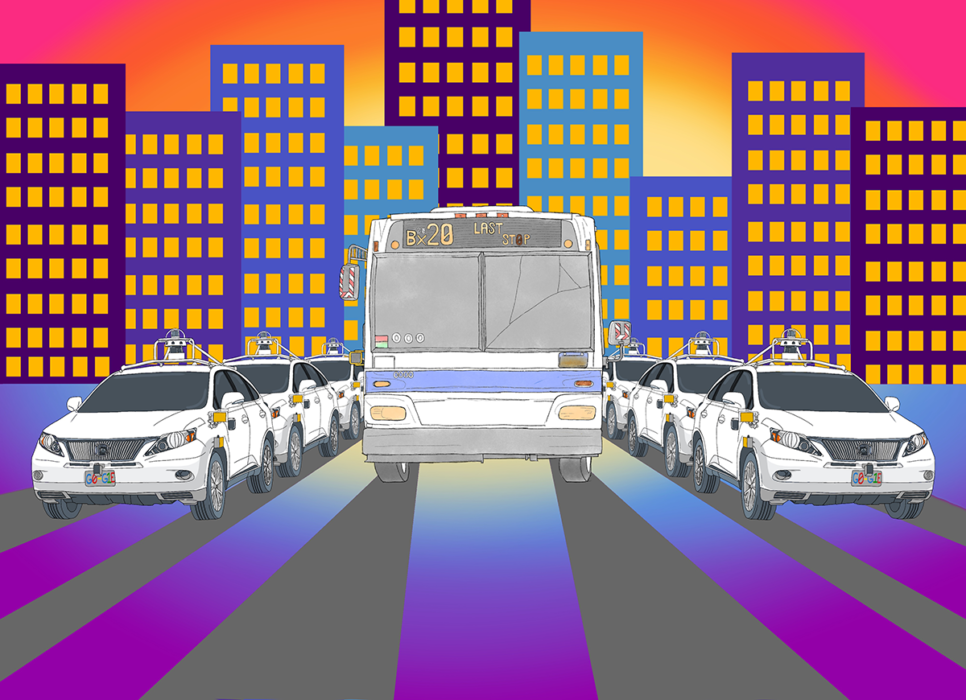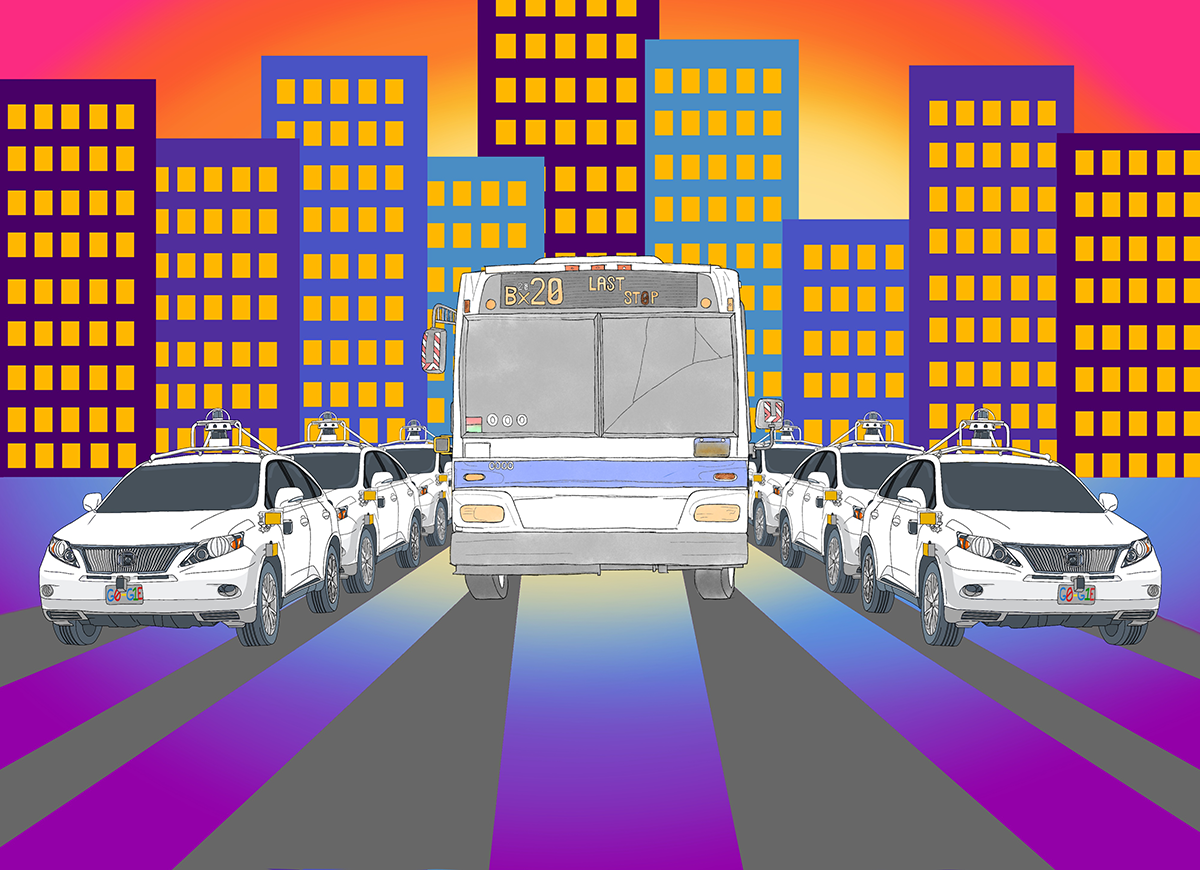
On April 22, Elon Musk, the hyperbolic CEO of electric-car maker Tesla, promised that, within a year, his company would have 1 million fully self-driving vehicles on the road that would operate as a sort of taxi fleet. Tesla owners, Musk surmises, will be able to rent out their vehicles when they would otherwise be sitting in the driveway. It will be cash for the car owner, and an on-demand ride for the customer.
“It’s financially insane to buy anything other than a Tesla,” Musk said. “[That] would be like owning a horse in three years.”
Musk’s prediction was immediately panned by autonomy experts (few believe cars will be able to fully drive themselves in a year, if ever) and investors (Tesla share prices fell 4 percent that day). But he may be partially right about ride-sharing and autonomous vehicles improving mobility in the future, even in traffic-choked cities. In fact, some Western transit agencies are even embracing the new technology, but to see how it’s working one must leave the realm of Silicon Valley CEOs and look instead to senior citizens in Phoenix.
Valley Metro, the Phoenix area’s transit agency, partners with ride-hailing service Lyft to help seniors and other mobility-challenged folks get around if using a bus isn’t feasible. Through its RideChoice program, riders pay $3 for the first eight miles of a Lyft ride, and $2 per mile after that. Instead of scheduling rides 24 hours in advance, as is common with paratransit, RideChoice only requires about an hour of lead time. As soon as this summer, some customers will have even more high-tech options: in addition to Lyft and traditional taxis, autonomous vans built by Google subsidiary Waymo will be at their service.
Perhaps counterintuitively, partnerships like this, in which cities and transit agencies work in conjunction with Lyft, Uber, Waymo, and the like, could make residents less reliant on personal vehicles in the future. In a roundabout way, that could make a small dent in the West’s car-obsessed culture.
“From a mobility perspective, there’s a lot of reasons to be excited,” said Joseph Schwieterman, a DePaul University public policy professor who examines such partnerships. “There’s a huge segment of the population for whom, unfortunately, [public] transit just isn’t an option.” By working together with ride-hailing firms, transit agencies are broadening their services in areas where it would be too costly to install new lines.
Phoenix isn’t the only Western city experimenting with ride-hailing partnerships. Pierce Transit in Tacoma, Washington, offers discounted Lyft rides between transit-poor neighborhoods and the closest terminals. Transit apps in Portland and Los Angeles include ride-share services when displaying route options. Some have gone even farther: transit in suburban Monrovia, California, is now essentially made up of subsidized access to Lyft rides and dockless bike-sharing through LimeBike.
Many transit agencies struggle to provide what they call “first mile, last mile” solutions. In sparsely populated areas, the nearest bus stop is often too far for a rider to justify walking to, so that person drives instead. Adding more buses in these areas would be cost prohibitive. “We’d just be basically running empty buses through some of these suburban areas,” said Joe Gregory, Valley Metro’s manager of service planning. “We want to serve customers out there, but we want to find a smaller, more personal way that will work better in their neighborhood.” Valley Metro leaders think it’s possible Waymo autonomous vehicles will do just that near every bus stop and rail station.
Low-income residents pushed farther and farther from city centers in Western boomtowns could benefit from this model. According to University of California, Los Angeles urban planning professor Evelyn Blumenberg, the research is clear: having access to a car opens up economic opportunities. “What ride-hailing does is it enables a household to have access to an automobile … and you just pay for the trips that you need,” she said.
Ride-hailing offers other complementary perks to public transit. In far-flung neighborhoods, buses often show up only every half-hour to an hour, which can be an interminable wait in Phoenix’s heat or Tacoma’s rain if you just miss the bus. It can also be a matter of safety — as Blumenberg points out, many women would prefer an Uber ride to waiting around at a dark bus stop at night.
There is still a potential clash of visions, however. Waymo and Uber have espoused their own version of Musk’s techno-optimistic future: fleets of self-driving vehicles, continuously cruising around and picking up passengers who, given this newfound convenience, are eschewing car ownership. “From a mobility perspective, it’s great,” said Brian Taylor, director of UCLA’s Institute of Transportation Studies. But, he added: “if the goal is to manage auto dependence, it’s a disaster.”
An analysis by a former New York City deputy traffic commissioner found that Uber, Lyft, and the like resulted in 5.7 billion more miles driven per year in nine U.S. metros, including Seattle, L.A., and San Francisco. Pedestrian advocates and some liberal city councils have begun to speak of Uber, Lyft, and Waymo as scourges threatening urbanism. Self-driving cars, after all, are still cars.
But it’s important to remember that like the technology itself, transit agencies’ partnerships with autonomous-car firms and ride-hailing companies are still in their infancy. And, in reality, there aren’t many Uber and Lyft vehicles out there. According to the National Household Travel Survey, just 0.5 percent of trips nationwide were taken in a for-hire vehicle in 2017. “It’s a drop in the bucket,” Taylor said.
And early days means there’s still room to change habits. Taylor says overall ride-hailing use can be curbed through congestion pricing policies, for example, which can prod people to take the bus or ride their bike instead, and fund better transit.
Angie DeVore, who manages Valley Metro’s business technology services, agrees. “We believe that being able to partner with [autonomous vehicle technology] at this stage in the game is going to be beneficial for transit in the long run,” she said.
So when you picture that future full of self-driving cars, whether it’s one year away or fifty, remember to also picture the bus.

